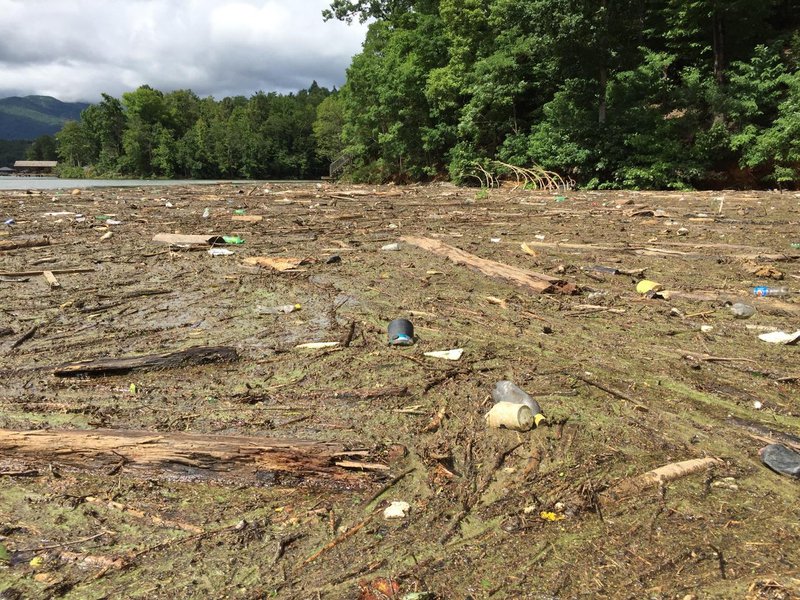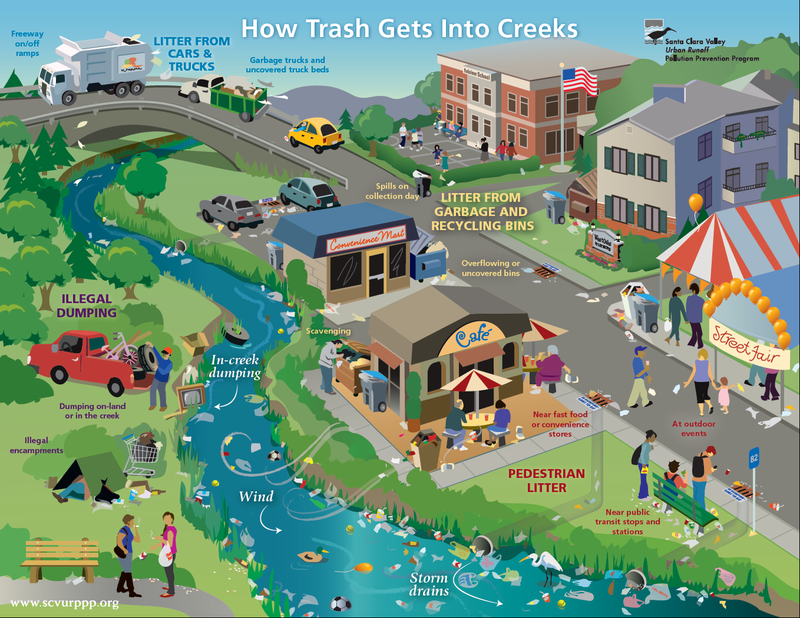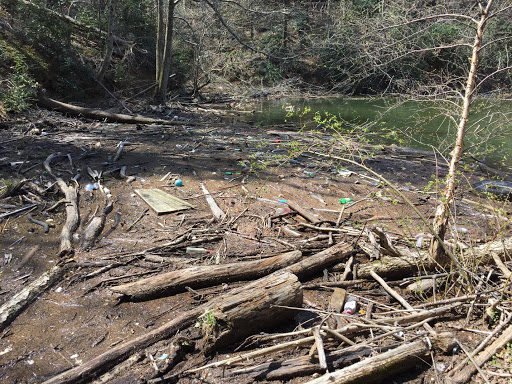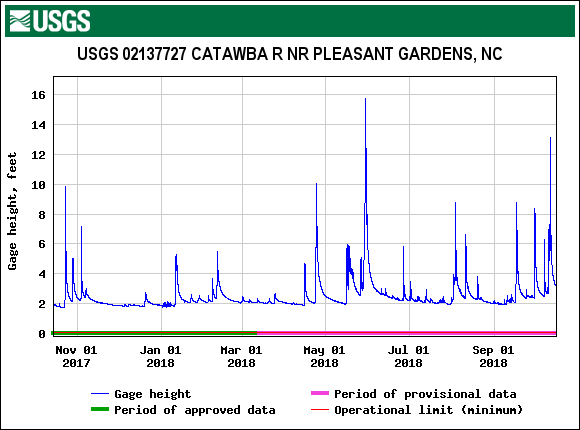Background
According to the 1972 Clean Water Act, trash in a waterway is a “pollutant” which “prevents beneficial uses, degrades habitats and harms wildlife, and may endanger people’s health.” The North Carolina Department of Environmental Quality (NC DEQ), in cooperation with the EPA and in accordance with its obligations under the act, prepares a list every 2 years of those water bodies in NC where trash and/or other forms of pollution are in such excess that they do not meet water quality standards. This list is known as the Section 303(d) list or list of impaired waterways, and getting on this list is frequently the first step in receiving widespread focus and potentially state and federal funding in order to address a pollution problem. Unfortunately, the emphasis in this statute is on remediation rather than prevention.
Over 200 waterways nationwide are on the Section 303(d) list as a result of trash problems alone. Most of these waterways are located in or adjacent to large urban areas, and some have used new ideas and/or exciting new technologies in an attempt to fix their trash problem. Although the problem exists, no designated trash impaired waterways are located in NC. However, there are a large number of waterways in NC on the 303(d) list for other reasons. These reasons include failure to meet chemical, biological, sedimentation, or other standards.
Unfortunately, neither the EPA or the State of NC currently have established standards for measuring water quality as a result of trash. Both the lack of scientific/measurable criteria as it pertains to trash and the lack of existing trash data contribute to this result. Conversely, both the EPA and NC DEQ encourage local jurisdictions (i.e. county) to develop their own criteria for trash impairment. This has been done in many river basins around the US. There is even an EPA newsletter entitled “The Flow of Trash Free Waters” that supports this effort.
No established standards currently exist in McDowell and Burke counties for trash in the lake or waterways. For many reasons, officials in both counties should consider establishing waterway trash standards. This is especially the case in McDowell. As can be seen on a high level watershed map, the overwhelming majority of surface area drainage into Lake James (at least 85%) emanates from McDowell County.
The amount of trash in Lake James and its watershed should be of great concern to many different constituents, including Marion residents on city water, property owners at the lake, boaters of all types, swimming enthusiasts, commercial interests, conservationists, and community leaders alike. Having a problem to this extent is not consistent with Lake James’ widespread reputation as a clean and pristine lake. See the pictures and associated labels below as visual evidence of Lake James’ trash problem, and then as an example that paints an entirely different picture, view a recent Crescent Resources promotional video here.

Between Black Forest and the Arbor, August 2018
Trash accumulation from upstream sources in the main channel of Lake James after a typical rain event. Video taken August 3rd, 2018
More specifically, trash in the Lake James watershed is:
- visually offensive and out of place for a pristine viewshed
- impacts recreational experience and swimming safety
- harms fish, turtles, birds, and other wildlife
- can leach harmful chemicals
- can introduce dangerous pathogens such as in those contained in medical wastes
- can accumulate and take hundreds of years to biodegrade in the environment
- can pose a navigational safety hazard to boaters and children being towed on skis or rafts behind boats
- can affect the safety of drinking water
- can affect property values and the resulting tax base
- can affect the economic development opportunities of an entire region
Recent scientific study has led to heightened concern regarding microplastics. Microplastics are the microscopic fragments of non-biodegradable plastic bottles, etc. that cannot be filtered from drinking water and have been shown to accumulate in the bodies and tissues of organisms. More research is being conducted, however, this emerging concern could be a driving force in the near future for the EPA and the State of NC to develop more specific water quality standards regarding trash. As most citizens already know, the city of Marion has applied for permission and will shortly begin drawing some portion of its daily drinking water directly from Lake James. See the most recent City of Marion “Source Water Protection Plan” from December 2009 here. This plan has not yet been updated to account for the City of Marion’s plans to begin drawing a portion of its drinking water from Lake James.
The above trash concerns are all the more unacceptable given that Lake James is a “headwaters lake,” which means that unlike lakes that are further down in the chain, it doesn’t receive water over long distances or from other polluted sources. Instead, Lake James benefits from being located in a mostly rural area and having source waters that flow out of the nearby mountains and through mostly forested areas. To read about what value forested areas afford to surface water such as Lake James (which will become a source of drinking water for the City of Marion in the near future), see link to the USDA’s website “Forests to Faucets” here.
As noted above, the water quality of Lake James mostly benefits from its geographic location in a rural and forested corner of the state. That said, its 380 square mile drainage area (mostly located within McDowell County) and the many rivers and streams that feed it (there are 26 tributaries of the Catawba River itself above Lake James) complicate the task of developing an effective trash management plan. (See overview map of the entire Lake James watershed here).
For an interesting comparison, see here the trash challenges faced by Jordan Lake, which is in the Cape Fear River Basin. Its drainage area is over 1700 square miles and includes both Greensboro and the Triad. Over 720,000 people live in the Jordan Lake watershed. This compares to a total population of only 44,000 in McDowell County, 8,000 of whom are in Marion, the county’s largest city. Given the relatively small drainage area of Lake James, as well as its mostly forested and rural nature, the amount of trash found in Lake James is inexcusable. McDowell County has both a great opportunity as well as a serious responsibility to lead the effort to develop a more complete watershed trash protection plan.
It is estimated that 80% of the trash that ends up in Lake James is a result of trash that flows into it from upstream sources and is not the result of careless boaters, fisherman, and others using the lake in general. Moreover, roughly 75% of the entire water volume entering Lake James enters on the far western side from the Catawba and North Fork Rivers. See an EPA schematic that provides a good illustration of the problem below.

Unlike the Linville River, which flows through the Linville Gorge Wilderness Area before entering the lake, the rivers on the western side of the lake are bordered by more urban-like areas of development, seasonal campgrounds, logging, agricultural, and commercial interests. As a result of the flow, the western end of the lake is more meaningfully impacted by trash, and this is especially the case during rain events. These occur with regular frequency and in essence, flush the trash from roads, low lying flood prone areas, and riverbanks into the lake where it accumulates, mostly in remote coves. Ironically, many of these coves are protected by Duke Energy as “environmentally sensitive areas”, and no shoreline stabilization or other building activity is permitted. See a partial map of the two main rivers upstream of Lake James here as they wind their way through McDowell County and note the known litter hotspots, illegal dumping sites, buildings, RV parks, campgrounds, and other potential trash contributors located within the designated flood plain.

Typical (non-flood) state of a cove in Lake James
The USGS (United State Geological Survey) maintains a streamflow monitoring station on the Catawba River at Pleasant Gardens. Looking back one year to November 2017, the gage height during normal flows reads at about 2-3 feet. Flood stage is considered 11 feet or more. However, it has been documented through pictures that the western end of the lake receives significant inflows of trash in connection with stream flows over 8ft. in gage height, including one especially nasty episode in early August 2018 when gage height reached almost 9 ft. This was only the fifth worst rain event over the period observed. All told over the past year there were 7 separate rain events where gage height reached 8 ft or more. The worst events occurred 10/17/17 (10 ft.), 4/30/18 (10 ft.), 5/30/18 (16 ft.), and 10/11/18 (13 ft.).

Very little hard data exists with regard to the specific source, type, and rate of buildup of trash in the Lake James’ watershed. However, “Keep McDowell Beautiful” has been conducting a weekly trash survey at the Catawba River Park for the past 2 years. Although conducted at only one location, a review of survey results indicate the types of litter found at this location and the high rate at which littering and illegal dumping is occurring. See the detailed results from 2017 and 2018.
One recent factor that has impacted the amount of trash that accumulates on roadsides and streambanks and consequently finds its way into the watershed is the State of North Carolina’s decision beginning in 2017 to do away with roadside pickup by prisoners. For years law makers had been fielding complaints from the 50% of counties across NC not served by a state prison and apparently not participating in the prisoner roadside pickup program. Beginning in 2017 the state legislature decided to do away with the prisoner pickup program (funded and administered by DPS) and move to a vendor arrangement (funded and administered by DOT). Due to a significant taxpayer cost difference and only slightly less taxpayer funding, NC road miles picked up has gone from a high of 85,000 miles in 2009 to only 17,000 miles in 2017. This represents an 80% decline in covered roads with the only 2 roads in McDowell County currently receiving vendor attention being I-40 and US Route 221. Local government has not stepped in to fill the void that was created by this change, and until there is a local solution, this impacts the amount of trash that flows into the watershed and eventually into the lake. Note here the close proximity of many roads no longer serviced for trash pickup by prisoners or vendors to the watershed and flood plain.
Not unlike many rural counties in NC, McDowell County does not provide residential solid waste pick up services. McDowell County does however operate seven “convenience centers.” These centers handle household waste and provide recycling bins. In order to dispose of trash, residents can either contract privately or take their trash to one of these centers. With the exception of the Highway 226 site, the centers are open 4 days a week from 6:30 AM until 6:30 PM. See a map of the convenience center locations in McDowell County here. While not an acceptable excuse for illegal behavior, it is possible that one of the factors contributing to the buildup of streambank and roadside trash is the long distance some residents have to travel to the nearest convenience center and/or the limited days and hours of convenience center openings.
The Sheriff’s Office in McDowell County is one government entity with primary responsibility for enforcing statewide litter ordinances. Intentional littering under 15 pounds can carry a fine of up to $1,000 for a first offense. “Dumping” over 500 pounds can be a Class I felony and result in up to a $15,000 per day fine. Littering and dumping violations are very hard to detect and very hard to prosecute. The State of NC reported that a total 3,320 littering citations were issued statewide last year resulting in 1,078 convictions. No information is available on local citations issued and/or convictions, however, McDowell County’s position of “environmental compliance officer” went unfilled for several years following the retirement of the previous individual in this role. In an effort to control illegal littering and dumping, McDowell County should strictly enforce current litter laws.
Some portion of the accumulated trash is picked up each year in two annual Lake James volunteer cleanup events, one on the Burke side and one on the McDowell side. Clean up efforts are primarily sponsored by Lake James Area Wildlife and Nature Society and Keep McDowell Beautiful respectively. The work is difficult (because access to many of the rugged coves from the land is almost impossible) and dangerous (because of all the woody debris trapped in the coves and some types of trash found, i.e. hypodermic needles). In addition, varying water levels, getting an ample number of young volunteers and volunteers with boats, and the frequency with which the cleanups are conducted are also limiting factors. Although cleanups are necessary, it would be much better to find a way to stop the trash at its source before it gets into the lake where it is accumulates and is extremely difficult to remove.